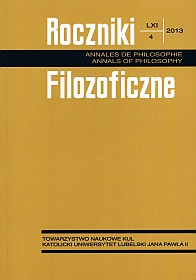Tetrad, or the Fourfold Pattern of Cultural Transformations
Abstract
This paper seeks to discuss the tetradic structure of cultural transformations effected by human artifacts. It was Marshall McLuhan’s main idea to think of our historical changes in terms of various modes of communication. Each mode introduces a new form of human interaction. The spoken word produced coherent communities. The written word caused fragmentation. McLuhan believed that electronic artifacts would restore the lost integrity. His tetradic structure of cultural changes was inspired by Gestalt psychology with its key pair: figure—ground. McLuhan thought that humanity is resonating within this two elements evolving from the culture of the written word to the culture of the spoken word. Eventually, we shall found ourselves in the acoustic space.
References
Baran J.S., Davis D.K.: Teorie komunikowania masowego, tł. A. Sadza, Warszawa: Wydawnictwo Uniwersytetu Jagiellońskiego 2007.
Baudrillard J.: Pakt jasności. O inteligencji zła, tł. S. Królak, Warszawa: Wydawnictwo Sic! 2005.
Baudrillard J.: Przejrzystość zła, tł. S. Królak, Warszawa: Wydawnictwo Sic! 2009.
Capra F.: Tao fizyki, tł. P. Macura, Kraków: Zakład Wydawniczy „Nomos” 1994.
Carroll N.: Filozofia sztuki masowej, tł. M. Przylipiak, Gdańsk: Słowo/obraz terytoria 2011.
Copleston F.: A History of Philosophy, t. 9, cz. I, Garden City: Image Books 1974.
Dilthey W.: O istocie filozofii i inne pisma, tł. E. Paczkowska-Łagowska, Warszawa: PWN 1987.
Goban-Klas T.: Media i komunikowanie masowe. Teorie i analizy prasy, radia, telewizji i Internetu, Warszawa: Wydawnictwo Naukowe PWN 1999.
Góźdź A.: Zrozumieć McLuhana, czyli o gorącej telewizji naszych czasów, [w:] A. Maj, M. Derda-Nowakowski (red.), Kody McLuhana. Topografia nowych mediów, Katowice: Wydawnictwo Naukowe ExMachina 2009, s. 109-122.
Japola J.: Tekst czy głos? Waltera J. Onga antropologia literatury, Lublin: RWKUL 1998.
Kłos J.: Pomiędzy determinizmem a indeterminizmem, [w:] M. Sokołowski (red.), Definiowanie McLuhana. Media a perspektywy rozwoju rzeczywistości wirtualnej, Olsztyn: Algraf 2006.
Kłos J.: Zawinięta tożsamość i poszukiwanie wspólnoty, czyli refleksje nad nowoczesnością, „Zeszyty Naukowe Katolickiego Uniwersytetu Lubelskiego” 55 (2012), nr 4 (220), s. 29-52.
Lodziak C.: The Power of Television. A Critical Appraisal, London: Frances Printer 1986.
Loska K.: Dziedzictwo McLuhana – między nowoczesnością a ponowoczesnością, Kraków: Rabid 2001.
McLuhan M.: Wybór tekstów, tł. E. Rożalska, J.M. Stokłosa, Poznań: Zysk i S-ka Wydawnictwo 2001.
McLuhan M., Powers B.R.: The Global Village. Transformations in World Life and Media in the 21st Century, New York: Oxford University Press 1989.
McQuail D.: Teoria komunikowania masowego, tł. M. Bucholc, A. Szulżycka, Warszawa: Wydawnictwo Naukowe PWN 2008.
Mickiewicz A., Dziady. Cz. III, Warszawa: Czytelnik 1974.
Ong W.: Oralność i piśmienność, tł. J. Japola, Lublin: RWKUL 1992.
Platon: Fajdros, tł. L. Regner, Warszawa: Wydawnictwo Naukowe PWN 1993.
Russo L.: Zapomniana rewolucja. Grecka myśl naukowa a nauka nowoczesna, tł. I. Kania, Kraków: Universitas 2005.
Sławek T.: McLuhan i NIC-ość techniki, [w:] A. Maj, M. Derda-Nowakowski (red.), Kody McLuhana. Topografia nowych mediów, Katowice: Wydawnictwo Naukowe ExMachina 2009, s. 91-108.
Szacki J.: Historia myśli socjologicznej, Warszawa: Wydawnictwo Naukowe PWN 2002.
Szewczuk W.: Teoria postaci i psychologia postaci, Warszawa: Departament Nauki Ministerstwa Szkół Wyższych i Nauki, 1951.
Toffler A.: Trzecia fala, tł. E. Woydyłło, Warszawa: PIW 1997.
Copyright (c) 2013 Roczniki Filozoficzne

This work is licensed under a Creative Commons Attribution-NonCommercial-NoDerivatives 4.0 International License.





